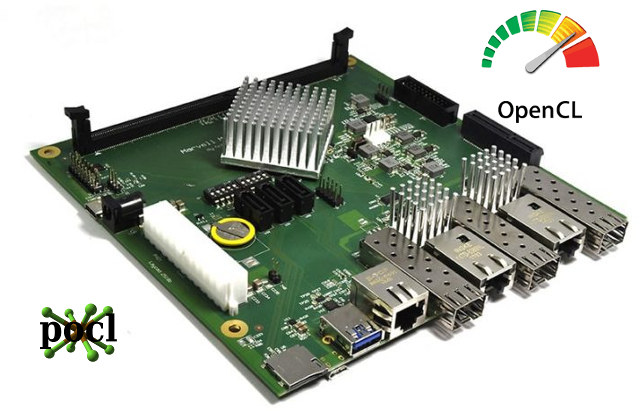This is a guest post by blu about his experience with OpenCL on MacchiatoBin board with a quad core Cortex A72 processor and an Intel based MacBook. He previously contributed several technical articles such as How ARM Nerfed NEON Permute Instructions in ARMv8 or OpenGL ES development on Ubuntu Touch.
Qualcomm launched their long-awaited server ARM chip the other day, and we started getting the first benchmarks. Incidentally, I too managed to get some OpenCL ray-tracing code running on an ARM Cortex-A72 machine that same day (thanks to pocl – an LLVM-based open-source OCL multi-platform implementation), so my benchmarking curiosity got me.
The code in question is an OCL (half-finished) port of a graphics demo from 2014. Some remarks of what it does:
For each frame: a single thread builds a sparse voxel octree from a dynamic voxel scene; the octree, along with current camera settings are passed to an OCL kernel via double buffering; kernel computes a screen-space map of object IDs from primary-ray-hit voxels (kernel utilizes all compute units of a user-specified device); then, in headless mode used in the test, the app discards the frame. Test continues for a user-specified number of frames, and reports the average frames per second (FPS) upon termination.
Now, one of the baselines I wanted to compare the ARM machine against was a MacBook with Penryn (Intel Core 2 Duo Processor P8600), as the latter had exhibited very similar IPC characteristics to the Cortex-A72 in previous (non-OCL) tests, and also both machines had very similar FLOPS paper specs (and our OCL test is particularly FP-heavy):
- 2x Penryn @ 2400MHz: 4xfp32 mul + 4xfp32 add per clock = 38.4GFLOPS total
- 4x Cortex-A72 @ 1300MHz: 4xfp32 mul-add per clock = 41.6GFLOPS total
Beyond paper specs, on a SGEMM test the two machines showed the following performance for cached data:
- Penryn: 4.86 flop/clock/core, 23.33GFLOPS total
- Cortex-A72: 6.52 flop/clock/core, 33.90GFLOPS total
And finally RAM bandwidth (again, paper specs):
- Penryn: 8.53GB/s (DDR3 @ 1066MT/s)
- Cortex-A72: 12.8GB/s (DDR4 @ 1600MT/s)
On the ray-tracing OCL test, though, things turned out interesting (MacBook running Apple’s own OCL stack, which, to the best of my knowledge, is also LLVM-based):
- Penryn average FPS: 2.31
- Cortex-A72 average FPS: 7.61
So while on the SGEMM test the ARM was ~1.5x faster than Penryn for cached data, on the ray-tracing test, which is a much more complex code than SGEMM, the ARM speedup turned out ~3x? Remember, we are talking of two μarchs that perform quite closely by general-purpose-code IPC. Could something be wrong with Apple’s OCL stack? Let’s try pocl (exact same version of pocl and LLVM as on ARM):
- Penryn average FPS: 11.58
OK, that’s much more reasonable. This time Penryn holds a speed advantage of 1.5x. Now, while Penryn is a fairly mature μarch that has reached its toolchain-support peak long ago, could we expect improvements from LLVM’s (and pocl’s) support for the Cortex family? Perhaps. In the case of our little test I could even finish the Aarch64 port of the non-OCL version of this code (originally x86-64 with SSE/AVX), but hey, OCL saved me the initial effort for satisfying my curiosity!
[Update: See comment for new ARM Cortex A72 and A53 results after fixing some codegen issues]
What is more interesting, though, is that assuming a Qualcomm Falkor core is at least as performant as a Cortex-A72 core in both gen-purpose and NEON IPC (not a baseless supposition), and taking into account that the top specced Centriq 2400 has 12x the cores and 10x the RAM bandwidth of our ARM machine, we could speculate about Centriq 2400’s performance on this OCL test when using the same OCL stack.
Hypothetical Qualcomm Centriq 2400 server: Centriq 2400 48x Falkor @ 2200MHz-2600MHz, 6x DDR4 @ 2667MT/s (128GB/s)
Assumed linearly scaling from the ARMADA 8040 measured performance; in practice the single-thread part of the test will impede the linear scaling, and so could the slightly-lower per-core RAM BW paper specs.
|
1 2 3 4 |
$ echo "scale=4; 48 * 2.2 / (4 * 1.3) * 7.61" | bc 154.5408 $ echo "scale=4; 48 * 2.6 / (4 * 1.3) * 7.61" | bc 182.6400 |
Of course, CPU-based solutions are not the best candidate for this OCL test — a decent GPU would obliterate even a 2S Xeon server here. But the goal of this entire test was to get a first-encounter estimate of the Cortex-A72 for FP-heavy non-matrix-multiplication-trivial scenarios, and things can go only up from here. Raw data for POCL tests on MacchiatoBin and MacBook is available here.

Jean-Luc started CNX Software in 2010 as a part-time endeavor, before quitting his job as a software engineering manager, and starting to write daily news, and reviews full time later in 2011.
Support CNX Software! Donate via cryptocurrencies, become a Patron on Patreon, or purchase goods on Amazon or Aliexpress





